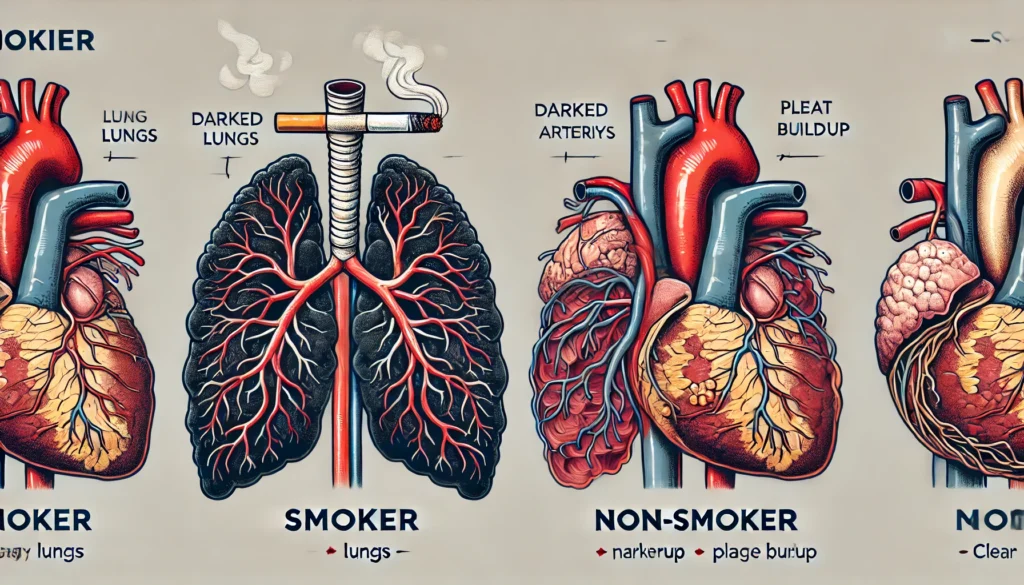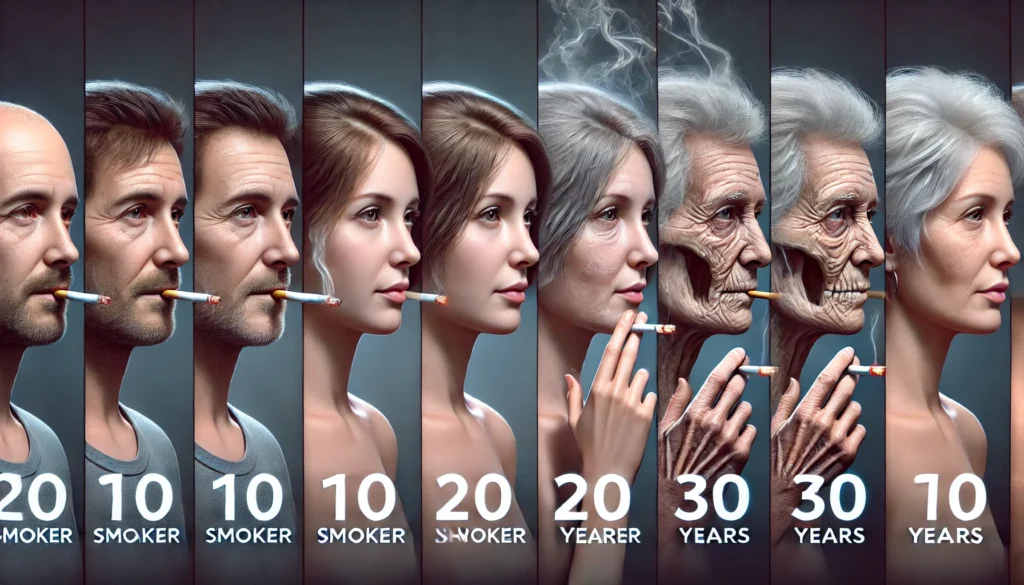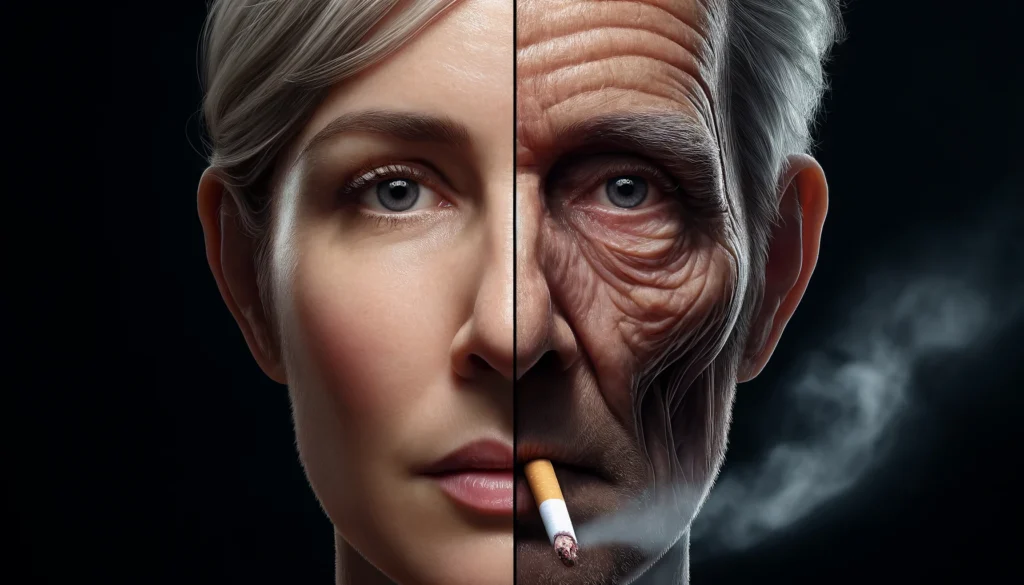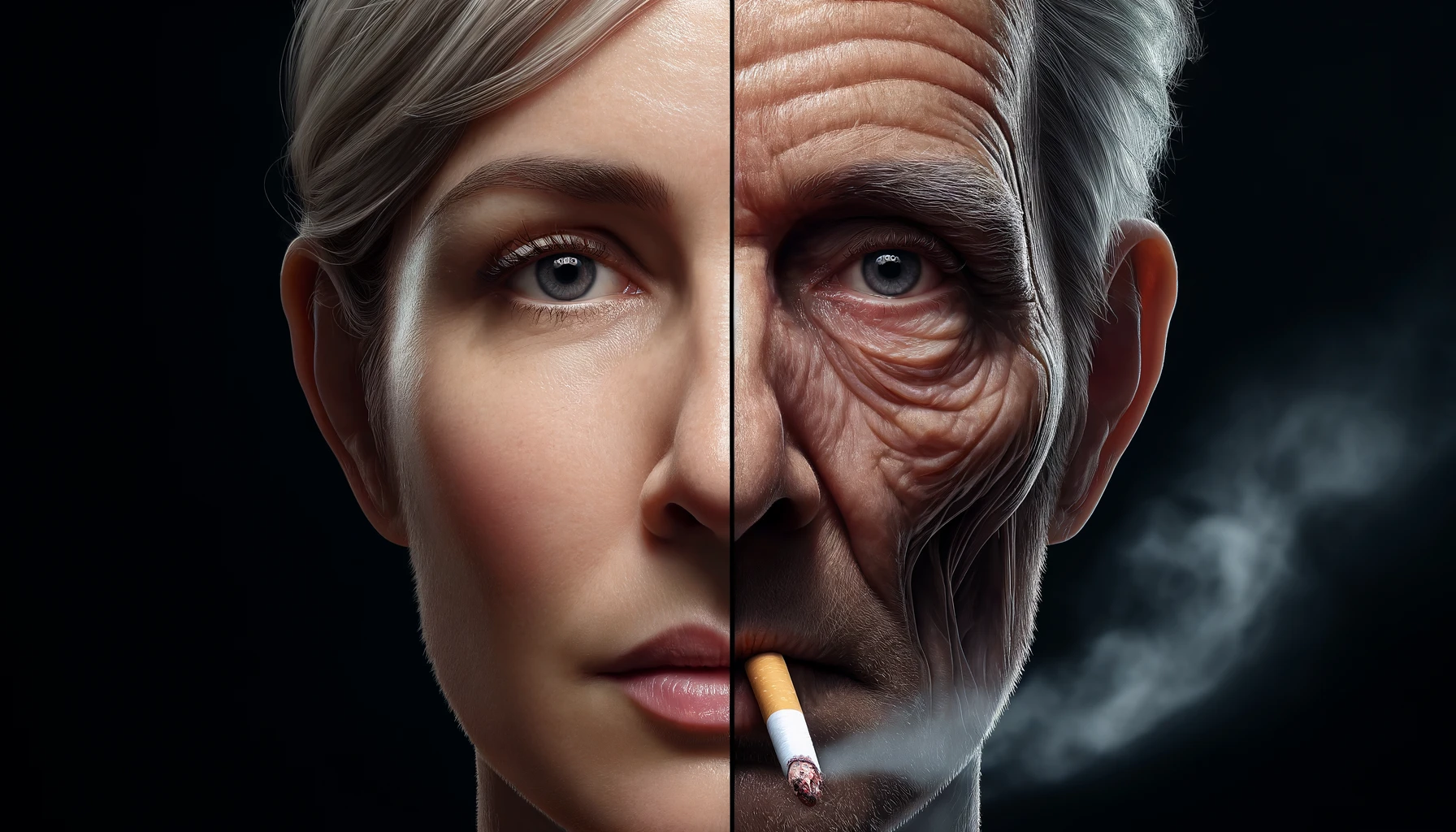In the modern era, the quest for longevity and youthful vitality has become a central focus for many. While numerous factors influence the aging process, smoking stands out as a significant contributor to premature aging. As of early 2025, extensive research has deepened our understanding of how smoking accelerates aging, affecting both appearance and overall health.
Table of Contents
The Biological Impact of Smoking on Aging.
Cellular and Molecular Damage.
Visible Signs of Aging Attributable to Smoking.
The Benefits of Smoking Cessation on Aging.
Reversal of Premature Aging Signs.
Global Perspective on Smoking and Aging.
Top 25 FAQs on the Link Between Smoking and Early Aging.
The Biological Impact of Smoking on Aging
Cigarette smoke contains over 7,000 chemicals, many of which are known to be harmful. When inhaled, these toxicants rapidly enter the bloodstream, reaching every organ, including the skin. This widespread distribution leads to systemic damage, manifesting in various ways that contribute to accelerated aging.
Cellular and Molecular Damage
One of the primary mechanisms by which smoking accelerates aging is through oxidative stress. The influx of free radicals from tobacco smoke overwhelms the body’s natural antioxidant defenses, leading to cellular damage. This oxidative stress affects DNA, proteins, and lipids, impairing normal cellular functions and promoting the aging process.

Moreover, smoking has been linked to epigenetic changes—modifications in gene expression without altering the DNA sequence. A study published in Clinical Epigenetics highlighted that exposure to cigarette smoke at different life stages is associated with accelerated epigenetic aging. These changes can predispose individuals to various age-related diseases, further emphasizing the detrimental impact of smoking on longevity.
Telomere Shortening
Telomeres, the protective caps at the ends of chromosomes, play a crucial role in cellular aging. Each time a cell divides, telomeres shorten, eventually leading to cellular senescence or death when they reach a critical length. Research indicates that smoking accelerates telomere shortening, effectively hastening the biological aging clock. This process not only contributes to visible signs of aging but also increases susceptibility to age-related diseases.
Visible Signs of Aging Attributable to Smoking
Beyond the internal physiological effects, smoking markedly influences external appearance, leading to premature aging signs that are often most concerning to individuals.
Skin Degradation
The skin, being the body’s largest organ, visibly reflects the adverse effects of smoking. Nicotine and other harmful substances in tobacco smoke constrict blood vessels, reducing blood flow and depriving the skin of essential nutrients and oxygen. This deprivation results in a sallow, uneven complexion and loss of elasticity.
Additionally, smoking increases the production of matrix metalloproteinases—enzymes that break down collagen and elastin, the structural proteins vital for skin firmness and elasticity. The degradation of these proteins leads to the formation of wrinkles and sagging skin. Notably, smokers often develop deep lines around the mouth, commonly referred to as “smoker’s lines,” and crow’s feet around the eyes.
A study highlighted by the American Osteopathic College of Dermatology (AOCD) noted that smokers in their 40s often exhibit as many facial wrinkles as non-smokers in their 60s, underscoring the profound impact of smoking on skin aging.
Oral Health Deterioration
Smoking significantly affects oral health, leading to issues that can make individuals appear older than their chronological age. Common oral manifestations include:
- Tooth Discoloration: The tar and nicotine in cigarettes stain teeth, resulting in a yellow or brown hue that is difficult to remove with regular brushing.
- Gum Disease: Smoking impairs blood flow to the gums, increasing the risk of infections and periodontal disease. This condition can lead to tooth loss and receding gums, both of which contribute to an aged appearance.
- Halitosis: Persistent bad breath is a common issue among smokers, stemming from the accumulation of tobacco particles in the mouth and the development of oral infections.
These oral health issues not only affect aesthetics but also have functional implications, impacting nutrition and overall quality of life.
Systemic Health Implications
The ramifications of smoking extend beyond visible signs, profoundly impacting overall health and accelerating the aging process systemically.
Cardiovascular Health
Smoking is a well-established risk factor for cardiovascular diseases. The chemicals in tobacco smoke damage the lining of blood vessels, leading to atherosclerosis—a condition characterized by the hardening and narrowing of arteries. This process increases the risk of heart attacks, strokes, and peripheral artery disease.
Moreover, smoking raises blood pressure and reduces good cholesterol (HDL) levels, further exacerbating cardiovascular risks. The cumulative effect of these changes accelerates the decline in cardiovascular health, a hallmark of aging.
Respiratory Function
The respiratory system bears the brunt of smoking’s harmful effects. Chronic exposure to tobacco smoke leads to inflammation of the airways and destruction of lung tissue, resulting in chronic obstructive pulmonary disease (COPD). COPD is characterized by a persistent reduction in airflow, making breathing increasingly difficult.
The progressive nature of COPD not only diminishes quality of life but also contributes to the frailty often associated with advanced age. Furthermore, smoking increases the risk of lung infections and cancers, compounding respiratory health challenges.
Cognitive Decline
Emerging research has established a link between smoking and accelerated cognitive decline. The Lothian Birth Cohort studies demonstrated that smokers experienced greater cognitive decline by age 80 compared to non-smokers. The mean IQ of current smokers was found to be 6.0 points lower than that of ex-smokers and 6.5 points lower than that of those who had never smoked. Ref: en.wikipedia.org
This cognitive deterioration is attributed to smoking-induced vascular damage and oxidative stress, which impair brain function and increase the risk of neurodegenerative diseases.
The Benefits of Smoking Cessation on Aging
While the detrimental effects of smoking on aging are profound, cessation offers significant benefits, many of which manifest rapidly and continue to accrue over time.

Immediate and Long-Term Health Improvements
Upon quitting smoking, the body initiates a series of reparative processes:
- Within 20 minutes: Blood pressure and heart rate begin to normalize.
- Within a few days: Carbon monoxide levels in the blood decrease to normal, enhancing oxygen transport.
- Within 48 hours: Nerve endings start to regenerate, improving senses like smell and taste.
- Within 3 months: Circulation and lung function show marked improvement.
- Within 1 year: Coughing and shortness of breath decrease as lung capacity improves.
- Within 1–2 years: The risk of coronary heart disease is reduced by half.
- Within 5–10 years: The risk of stroke aligns with that of non-smokers, and the likelihood of developing cancers of the mouth, throat, esophagus, and bladder significantly decreases.
- Within 10 years: The risk of dying from lung cancer is cut in half; risks for cancers of the larynx and pancreas also decline.
- Within 15 years: The risk of coronary heart disease matches that of a non-smoker, and the risk of developing chronic obstructive pulmonary disease (COPD) decreases.
These milestones underscore the body’s remarkable capacity to heal and rejuvenate once exposure to tobacco toxins ceases.
Enhanced Longevity
Smoking cessation has a profound impact on life expectancy. Research indicates that individuals who quit smoking by the age of 35 can gain an additional 6.9 to 8.5 years for men and 6.1 to 7.7 years for women. Even those who quit at 65 can add 1.4 to 2.0 years (men) and 2.7 to 3.7 years (women) to their lifespan. This demonstrates that it’s never too late to benefit from quitting smoking.
Reversal of Premature Aging Signs
Beyond internal health benefits, smoking cessation positively affects appearance:
- Skin: Improved blood flow restores nutrients and oxygen, leading to a healthier complexion and reduced wrinkle formation.
- Teeth and Gums: The risk of gum disease decreases, and with proper dental care, tooth discoloration can be addressed, leading to a brighter smile.
- Hair: Former smokers often experience improved hair health, with increased shine and reduced thinning.
These aesthetic improvements can enhance self-esteem and overall quality of life.
Global Perspective on Smoking and Aging
The global health community recognizes smoking as a leading cause of preventable death and a significant contributor to accelerated aging. The World Health Organization reports that tobacco use results in over 8 million deaths annually, including approximately 1.3 million non-smokers exposed to second-hand smoke.
Efforts to reduce smoking prevalence have shown promising results. Projections indicate that global tobacco smoking rates will decline from 27% in 2000 to 15.4% by 2025. This decline is attributed to comprehensive public health campaigns, stricter tobacco regulations, and increased awareness of smoking’s adverse effects.
In Australia, for instance, smoking remains the leading cause of preventable deaths, accounting for around 24,000 deaths annually. Despite declining smoking rates, health experts emphasize the importance of continued tobacco control efforts, support for cessation, and addressing the rise in nicotine vaping among young people.
Top 25 FAQs on the Link Between Smoking and Early Aging
1. How does smoking accelerate the aging process?
Smoking accelerates aging by reducing oxygen supply, increasing oxidative stress, and damaging collagen and elastin, leading to premature wrinkles, sagging skin, and other signs of early aging.
2. Can smoking make you look older than your actual age?
Yes, smoking can cause premature wrinkles, yellowed skin, and an overall dull complexion, making individuals appear older than their biological age.
3. What are the main skin-related effects of smoking?
Smoking causes dry skin, deep wrinkles, sagging, uneven tone, and slow wound healing due to reduced blood flow and collagen breakdown.
4. Does smoking cause hair loss?
Yes, smoking reduces blood circulation to hair follicles, leading to hair thinning, graying, and increased risk of baldness.
5. How does smoking affect your eyes and eye area?
It contributes to crow’s feet, under-eye bags, and an increased risk of cataracts and macular degeneration.
6. Can quitting smoking reverse skin damage?
Partially, yes. After quitting, improved blood flow and oxygenation help restore skin health, but deep wrinkles may not fully reverse.
7. How does smoking impact teeth and gums?
Smoking stains teeth, increases the risk of gum disease, causes bad breath, and can lead to tooth loss.
8. Does smoking lead to premature gray hair?
Yes, smoking accelerates oxidative stress, which damages hair follicles and leads to early graying.
9. Is secondhand smoke also linked to early aging?
Yes, exposure to secondhand smoke can damage skin and contribute to aging effects similar to direct smoking.
10. How does smoking affect the body’s ability to heal wounds?
Smoking slows wound healing due to reduced oxygen supply, increasing the risk of infections and scars.
11. What role do free radicals play in smoking-related aging?
Free radicals from cigarette smoke damage skin cells, breaking down collagen and leading to premature aging.
12. Can smoking cause early menopause?
Yes, smoking can lead to hormonal imbalances, causing women to reach menopause 1–2 years earlier than non-smokers.
13. Does smoking affect bone health and aging?
Yes, smoking weakens bones, increasing the risk of osteoporosis and fractures, which are signs of aging.
14. How does smoking impact the cardiovascular system in relation to aging?
It damages arteries, increases the risk of heart disease, and reduces circulation, all contributing to premature aging.
15. Can smoking increase the risk of dementia or cognitive decline?
Yes, studies show that smokers are more likely to experience early cognitive decline and Alzheimer’s disease.
16. How does smoking affect lung aging?
Smoking accelerates lung aging, causing conditions like COPD and reducing lung capacity over time.

17. Is vaping safer for aging than smoking?
While vaping has fewer chemicals than cigarettes, it still contains harmful substances that contribute to premature aging.
18. Does smoking affect hydration levels in the skin?
Yes, smoking dehydrates the skin, making it dry and more prone to wrinkles.
19. How does smoking impact your immune system and aging?
It weakens the immune system, making the body more vulnerable to infections and chronic diseases associated with aging.
20. Does nicotine replacement therapy help slow down aging effects?
Quitting smoking through nicotine replacement can prevent further aging damage but won’t reverse existing wrinkles completely.
21. How soon can you see improvements in skin after quitting smoking?
Within weeks of quitting, skin tone improves, and within months, collagen production begins to recover.
22. Are there specific skincare products that help smokers’ skin recover?
Antioxidant-rich serums, retinoids, and vitamin C creams can help repair some damage caused by smoking.
23. Does smoking affect hydration and elasticity in the skin?
Yes, it reduces moisture retention and breaks down elastin, making skin less firm and more prone to wrinkles.
24. Can a healthy diet counteract smoking-related aging?
A diet rich in antioxidants, vitamins, and hydration can help mitigate some damage but won’t fully reverse smoking’s effects.
25. What is the best way to prevent smoking-related aging?
The best way is to quit smoking, maintain a healthy lifestyle, and adopt a good skincare routine to slow aging effects.
Conclusion
The link between smoking and accelerated aging is unequivocal. From cellular damage to visible signs of premature aging, the detrimental effects of tobacco are pervasive. However, the human body exhibits a remarkable ability to heal. Smoking cessation not only halts further damage but also initiates a cascade of reparative processes that can restore health and vitality. Embracing a smoke-free lifestyle is a pivotal step toward enhancing longevity and preserving youthful vigor.
As of February 2025, the global decline in smoking rates offers a hopeful outlook. Continued public health initiatives, coupled with individual commitment to cessation, can further mitigate the aging effects of smoking, leading to healthier, longer lives worldwide.
Health Related






I cherished up to you’ll receive performed proper here. The cartoon is tasteful, your authored material stylish. nevertheless, you command get got an shakiness over that you wish be handing over the following. in poor health no doubt come more in the past once more as exactly the similar just about very regularly inside case you protect this hike.